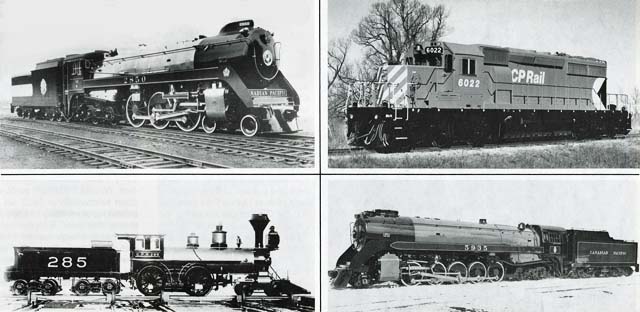
Number 6
April 27, 1983
to Yield to Diesels
By GORDON LOGAN

Canadian railway buffs can easily remember Royal Hudsons on the prairies or smooth-of-snout Selkirks unrolling plumes of white smoke in the Rockies. And 2-8-2s (an arrangement of two smaller wheels at the front of the locomotive, eight driving wheels in the middle, and two smaller wheels in back) hurling cascades of steam.
The reciprocating steam locomotive was really an amazing machine, a horizontal fire tube boiler with a furnace at one end, a pair of huge cylinders at the other, and slabs of steel rods attached to spoked driving wheels as tall as a man. Once in motion, add a shower of cinders, the heat of hades and thunderous noise.
While some love them, others argue that the sweetest railway sound ever is the deep-throated hum of matched six-axle, 3,000-horsepower diesel-electrics, with as many as 120 cars stretched behind, rumbling through the countryside.
The first steam locomotive built by the Canadian Pacific Railway was Number 285, a standard type 4-4-0, which rolled from the company's Delorimier Avenue Shops in Montreal in November, 1883. Its size and proportions agreed essentially with the great majority of freight engines in use on North American railways at that time.
If there was such a thing as a "typical" Canadian Pacific steam locomotive, familiar throughout Canada from Atlantic to Pacific, that title, surely, was attributable to the 502 units of the D10 class.
Built between 1905 and 1913, these sturdy, reliable and versatile 4-6-0s formed the backbone of the freight locomotive fleet.
Capable of a multitude of tasks complementary to main line operations, at home alike on freight, mixed, and passenger trains, in yard, pusher, and work services, they could be found in just about every engine house from Nova Scotia to Vancouver Island.
Almost as popular was the "Pacific" type steam locomotive, a 4-6-2, built between 1906 and 1914. The C.P.R. owned 498 of these units, many of them in service for more than 40 years, some for more than half a century.
Old-time railwaymen can drop the type names of steam locomotives with the ease of a 10-year-old identifying today's automobiles. Names like Atlantic, Sante Fe, and Jubilee. Moguls, Mountains, and Mikados. They remember the Decapods, Northerns, and Consolidations, and love Hudsons and Selkirks.
The "Hudson" type locomotives, there were 65 of them in C.P.R. service, first appeared on Canadian Pacific lines in 1929 and 1930 when 20 locomotives were built for heavy passenger services requiring reasonably high speeds. These original units were not streamlined, as were the remaining 45 built during and after 1937.
One Hudson, Number 2850, was specially selected to haul the 1939 Royal Train and was refinished in royal blue and aluminum with a royal crown at the front of each running board. Thus, the 2820-2864 series of C.P.R. Hudsons came to be known as "Royal Hudsons."
Incidentally, the 2850 hauled King George VI and Queen Elizabeth 3,388 miles (5,452 kilometres) on their tour of Canada.
CONTEST
The 5900 series 2-10-4 Selkirks, measuring just short of 100 feet long (30 metres), were the largest and heaviest steam locomotives in the Commonwealth.
(In the United States, locomotives of this wheel arrangement were known as "Texas" types, but in the 1930s, a contest among Canadian Pacific employees resulted in the name "Selkirk", after one of the mountain ranges in British Columbia where these impressive locomotives were in daily operation.)
Those who yearn to see a Selkirk can visit Heritage Park in Calgary, where Number 5934 is on display, or the Canadian Railway Museum at Delson near Montreal where Number 5935, the last of its breed and the last standard-gauge steam locomotive built for a Canadian railway, is on display.
Museum pieces at the age of 16, these C.P.R. Selkirks were the last of the great steamers to yield to technological advances in the post-war era.
The C.P.R. accepted delivery of Number 5935 in 1949, the same year it acquired its first diesel-electric road locomotive, a six-axle 2,250 horsepower unit, numbered 1800, built by the Electro-Motive Division of General Motors at LaGrange, Illinois.
The diesel-electric units were used initially on the Montreal-Boston passenger run in conjunction with the Boston amp; Maine Railroad. Similar models can still be seen today on main line and suburban services.
The very first diesel-electric locomotive owned by Canadian Pacific was a type B-B switcher, numbered 7000, purchased in 1937. The 550 horsepower unit, built at the National Steel Car Corporation in Hamilton, served on C.P.R. lines for five years. It was sold in 1943 to an industrial plant and worked another 20 years before being retired and preserved.
By 1954, diesel-electric locomotives were performing 30 percent of passenger, 35 percent of road freight, and 55 percent of switching services for Canadian Pacific.
A short six years later, on 6 Nov 1960, the last steam locomotive operated by CP Rail, a Class A1e 4-4-0 built in 1887, Number 29, left Montreal on a special round-trip to St. Lin, Quebec.
It was inevitable that the diesel would win.
Steam locomotives hauling freight trains required major overhauls every 80,000 miles (128,744 kilometres), a diesel power unit in similar service runs 500,000 miles (804,650 kilometres) between overhauls.
Steam engines became less efficient power producers as they increased in size. Not so with diesels. The early ones were 1,200 horsepower each, by 1970 units of similar size were putting out 3,000 horsepower and more.
Unlike steamers, diesels can be hooked together, under the control of a single crew, to haul heavy trains. When steam locomotives were teamed together on a train, each needed its own crew to tend the fire and watch the boiler pressures.
And it was impossible to coordinate steamers so that each one in a team would turn out exactly the same power at the same instant.
But it is common to string together three or four diesels under the control of one crew, all power units in the train being linked electrically to the control panel in the head locomotive. (Westbound through Rogers Pass in British Columbia, CP Rail uses as many as 12 to move its 14,400 ton (13,064 metric tons) coal unit trains.)
Today, (1983) the six-axle, 3,000-horsepower multi-purpose SD40-2, a third generation diesel-electric, forms the backbone of the CP Rail road fleet.

